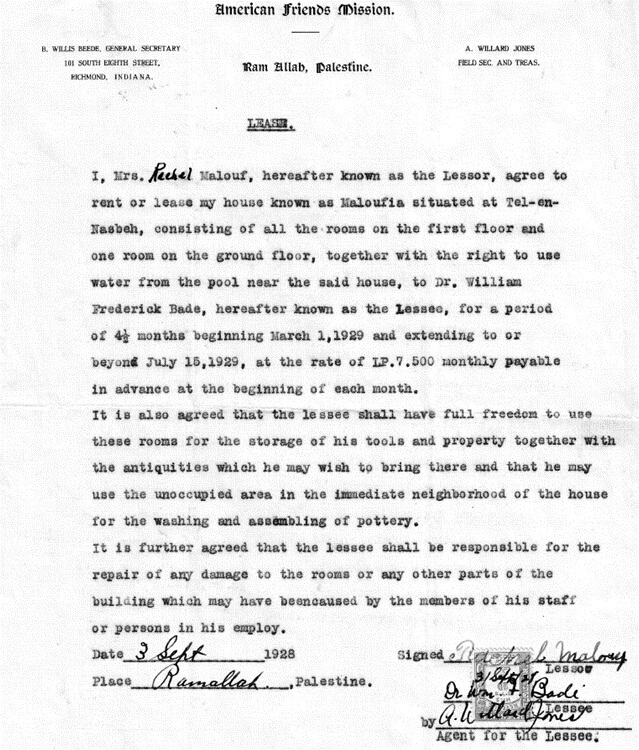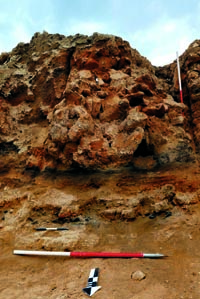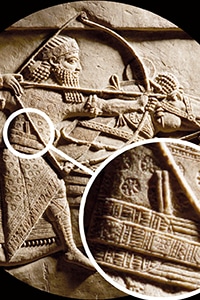
Not a Friend of ASOR yet? Sign up here to receive ANE Today in your inbox weekly!

June 2023
Vol. 11, No. 6
Archaeological Laborers of 20th-Century Palestine
By Melissa Cradic
Who were the workers who carried out excavation of archaeological sites in the “big dig” era of the early 20th century in Palestine? Under whose authority did they operate? How were these personnel hired and paid? What kinds of work did they carry out? These workers made critical contributions to the field, yet as seasonal continent laborers, they have remained uncredited and largely nameless in original field reports and in subsequent research on the history of archaeology. Why?
These questions are addressed in the open-access web exhibition, “Unsilencing the Archives: The Laborers of the Tell en-Naṣbeh Excavations (1926-1935).” With support of the 2021 Annual Grant from the Palestine Exploration Fund, this project presents new findings about an extensive legacy collection of unpublished archival holdings that are housed at the Badè Museum of Biblical Archaeology at Pacific School of Religion in Berkeley, CA. The archives document five seasons of excavation at the site of Tell en-Naṣbeh, which is located in El-Bireh, south of Ramallah in the present-day Palestinian Territories. At the time of the excavations in the 1920s and 1930s, this region was under the authority of the British Mandate Government of Palestine.

Figure 1. Lease agreement between Rachel Malouf, property owner in El-Bireh, Palestine, and W.F. Badè, director of the Tell en-Naṣbeh excavation project. The contract secures the rental of the dig house, El-Maloufiya, for the 1929 excavation season. Badè Museum Archive, Rachel Malouf Letters (1928). Courtesy of the Badè Museum, Pacific School of Religion.
Exhibiting the Badè Museum Archives
The Tell en-Naṣbeh archive consists of ca. 12,000 records and includes a range of documents, such as papers pertaining to excavation administration, personnel and pay records, travel tickets and visas, contracts and leases, excavation and export permits, registration records, sketches and site plans, field and travel diaries, and a large set of correspondence that was sent or received by the excavation director Prof. William F. Badè (Figure 1). In addition to the paper records, the archives also house a collection of several thousand field photographs in the form of negatives, prints, and hand-painted lantern slides (Figures 2-8).
An intriguing pattern emerges when combing through these documents and photographs: although the voice of Badè, along with high-ranking expedition staff members and archaeological colleagues such as W.F. Albright and Clarence S. Fisher, comes through loudly and clearly in their own words, the voices of those at the trowel’s edge remain silent. Yet their presence in the archives is anything but elusive. The photographic records in particular capture in detail the many key roles, colorful personalities, and essential contributions of the members of the contingent local workforce whose labor propelled the project and its success (Figures 2-3). Although voiceless and nameless in the records, the archives clearly illustrate the leading—rather than supporting—roles that these unsung participants played in the story of the Tell en-Naṣbeh expedition.
Reframing the Narrative
Until recently, studies on the history of archaeology in the Middle East have tended to focus on the legacies and lives of dig directors and big discoveries at major sites, and for good reason. Many of the pioneering techniques that developed in the early 20th century and the exciting finds that these important figures unearthed put archaeology on the map, establishing it as a serious discipline. Although controversial and viewed as highly problematic today, many early archaeological projects also left a lasting legacy by populating European and American museum collections with spectacular new resources that generated much public interest in the field.
While the accomplishments of the big names in the field — William F. Albright, James Henry Breasted, Clarence Fisher, Nelson Glueck, William Flinders Petrie, George Reisner, Alan Rowe, Leonard Woolley and many others — cannot be underestimated, until recently biographical narratives about them have tended to include little critical discussion about the colonial structures that permitted these projects and which placed Western staff in positions of intellectual, social, and economic authority over local communities on whose properties they carried out their digs (Figure 4). There has also been limited discussion of the problematic labor practices, such as hiring of a workforce of local men, women, and children for limited, unpredictable, and irregular seasonal terms with low pay, no benefits, and virtually no recourse for their treatment or to resolve disputes. Under the guise of offering economic development, these digs even frequently relied on child labor. Although such practices may have been the norm at the time, scrutinizing such labor practices today places these big dig projects in a new light.
The perspective is changing thanks to recent research by anthropologists, archaeologists, and historians whose work offers de-and post-colonial approaches that explicitly reframe the history of archaeology and study of archaeological labor. For instance, Allison Mickel’s (2021) recent monograph Why Those Who Shovel Are Silent: A History of Local Archaeological Knowledge and Labor (which won ASOR’s 2021 G. Ernst Wright book award) analyzes the production of archaeological knowledge in 20th and 21st century Jordan. Sarah Irving (2017) has enriched understanding of labor networks, skills, and agency of Arab workers in Palestine ca. 1890-1924. Wendy Doyon (2018) presents archaeological labor in Egypt through the eyes of Egyptian workers. Eric Cline (2020, 2022), focusing on the Oriental Institute’s 1920s-1930s excavations at Tel Megiddo, offers detailed information about the backgrounds and work lives of the Egyptian supervisors, called Quftis or reis, who worked at the site, many of whom also worked at Naṣbeh. Jack Green and Ros Henry’s (2021) volume highlights Olga Tufnell and her relationships with local communities while excavating at sites such as Lachish. Likewise, Digging Up Jericho: Past, Present, and Future (Sparks, Finlayson, Wagemakers, and Briffa, eds. 2020) offers a multivocalic perspective to the history of excavations at Jericho. The Badè Museum’s approach to its “Unsilencing the Archives” exhibit owes a debt to each of these authors and many more (see “Further Reading” below), including the foundational work by Stephen Quirke (2010), whose monograph Hidden Hands: Egyptian Workforces in Petrie Excavation Archives 1880-1924 sparked a critical trend that is gaining traction in Levantine archaeology.
Inspired by these studies, “Unsilencing the Archives” applies a similar approach tot he Badè Museum archives in order to reframe the traditional narrative and reveal the hidden hands behind the work (Figure 5). For example, because the published excavation reports do not list any of the Egyptian foremen(who carried the title of reis) or the other hired workers by name, trade or skill, we turned to the archives to answer questions such as: who were these field archaeologists and how were they hired on this project? What kinds of social and labor networks influenced hiring and retention of workers? More broadly, how can the study of the Tell en-Naṣbeh workforce move forward discussions about decolonizing archaeological and museum collections? Can simply attaching a name to a face—which are by-and-large nameless in the records—produce new meanings and contributions to the history of archaeology?
Invisible Labor at Tell en-Naṣbeh (1926-1935)
Drawing on the extensive archival collections, the exhibition tells the story of the unnamed day laborers and Egyptian foremen at Tell en-Naṣbeh. Despite overlooking their roles in publications about the site, Badè does acknowledge the expertise and experience that these personnel developed in his 1934 Manual of Excavation of the Near East (p. 20):
After several years of training, many of the local workmen become so expert that they do not require close supervision; and a foreman can manage a large gang efficiently when he has no novices. Experienced local workmen can sometimes be put in charge of minor gangs in less important areas.
Yet several pages later, he laments what he views as the ineptitude of his most valuable workers, the foremen themselves (p. 60):
Foremen generally are helpful in the presence of something unexpected, to which the rules they have learned in Egypt do not apply. They may either ignore it, or follow a rule of procedure that dictates perhaps the opposite of what should be done.
In contrast to this opinion, the excavation archives clearly capture the foremen’s deep experience excavating, documenting, and supervising digs as well as the special training that they contributed as highly skilled field archaeologists such as management of large groups of day workers, whom they trained, and their performance of specialized work such as pottery restoration, which directly informed interpretations of the site’s ceramic sequences, stratigraphy, and history (Figure 6).
Two foremen in particular, Reis Kureyim and, later, Reis Tantawi, specialized in professional pottery restoration and brought their skills to Tell en-Naṣbeh (Figures 7-8). These career field archaeologists carried out much of the pottery sorting and restoration themselves, as clearly attested in the photographic record, on film reels, and in letters about staff roles and responsibilities from season to season. However, instead of Reis Kureyim and Reis Tantawi receiving credit for their work for their multi-year contributions (Kureyim in 1929 and Tantawi in 1932 and 1935), with few exceptions, it is the American staff exclusively who are named in the staff list of the final report for their roles. This was not simply an oversight; the responsibilities of Reis Kureyim and Reis Tantawi were likely diminished because of established norms in the field and publications at the time, which were heavily influenced by the colonial setting and attitudes of the senior staff.
As this brief vignette has illustrated, this project has deepened understanding of the production of knowledge and the history of the archaeological labor at Tell en-Naṣbeh, revealing new insights into working conditions and the people who performed the project’s manual and intellectual labor. Yet this project only scratches the surface of the archives at the Badè Museum, placing them in dialogue with other archaeological collections from 20th century Palestine and in conversation with recent post-colonial and indigenizing perspectives to these materials, with many more insights about their complex histories yet to be revealed. It represents a starting point for renewed discussion about the colonial past of many 20th century big digs, the legacy collections that they produced, and the debts that the discipline owes to the many people who wielded pickaxes, carried buckets, sifted sediment, and sorted and cleaned pottery.
Melissa Cradic is Curator at the Badè Museum at the Pacific School of Religion, Digital Humanities Program Associate for The Alexandria Archive Institute, and Lecturer in History and Judaic Studies at SUNY Albany. She co-curated Unsilencing the Archives: TheLaborers of the Tell en-Nasbeh Excavations (1926–1935), which won ASOR’s Community Outreach and Public Engagement Award in 2022. The online exhibit is accompanied by a Youtube lecture series, “Unsilencing the Archives”, co-sponsored by the Badè Museum, Archaeological Research Facility, and Palestine Exploration Fund. An open-access edited volume based on the lecture series is currently in preparation in collaboration with co-editors Aaron Brody, Felicity Cobbing, Helen Dixon, and Samuel Pfister.
Author Acknowledgements
Special thanks to this project’s partners, especially exhibition co-curator Samuel Pfister and Badè Museum staff Aaron Brody, Brooke Norton, and Jessica Johnson. Thank you to the Palestine Exploration Fund for awarding this project the 2021 Annual Grant, with special gratitude to Felicity Cobbing for her support and collaboration at all phases of the project. I am also grateful to Nico Tripcevich and Sarah Kansa at University of California-Berkeley’s Archaeological Research Facility for their collaboration. Finally, thank you to Jeff Zorn, Eric Cline, and Allison Mickel for their feedback on the exhibition.
Further Reading
Cline, E.H. 2020. Digging Up Armageddon: The Search for the Lost City of Solomon. Princeton.
Cline, E. H. 2022. Invisible Excavators: The Quftis of Megiddo, 1925–1939. Palestine Exploration Quarterly.DOI: 10.1080/00310328.2022.2050085.
Doyon, W. 2018. The History of Archaeology through the Eyes of Egyptians. Pp. 173-200 in Unmasking Ideology in Imperial and Colonial Archaeology: Vocabulary, Symbols, and Legacy, ed. B. Effros and G. Lai. Ideas, Debates, and Perspectives. Los Angeles.
Green, J.D.M. and R. Henry (eds). 2021. Olga Tufnell’s ‘Perfect Journey’: Letters and photographs of an archaeologist in the Levant and Mediterranean. London.
Irving, S. 2017. A Tale of Two Yusifs: Recovering Arab Agency in Palestine Exploration Fund Excavations, 1890-1924. Palestine Exploration Quarterly 149 (3) 223–236.
Mickel, A. 2021. Why Those Who Shovel are Silent: A History of Local Archaeological Knowledge and Labor. Denver.
Quirke, S. 2010. Hidden Hands: Egyptian Workforces in Petrie Excavation Archives 1880–1924, London.
Roland, J. 2014. Documenting the Qufti Archaeological Workforce. Egyptian Archaeology 44: 10 – 12.
Sparks, R.T., B. Finlayson, B. Wagemakers, and J.M. Briffa, eds. 2020. Digging Up Jericho: Past, Present and Future. Oxford.
Want To Learn More?
 Tell Es-Sultan – A Pilot Project for Archaeology in Palestine
Tell Es-Sultan – A Pilot Project for Archaeology in Palestine
By Lorenzo Nigro
In 2014, students and young scholars of Rome “La Sapienza” University, along with Palestinian colleagues from the Ministry of Tourism and Antiquities, returned to Tell es-Sultan. Read More
Assurbanipal’s iPad: Wax Boards in the Ancient Near East
By Michele Cammarosano and Katja Weirauch
Writing on wax began in Mesopotamia and spread to the Mediterranean and Europe. But some lingering questions may have finally been answered by a science project with children. Read More

